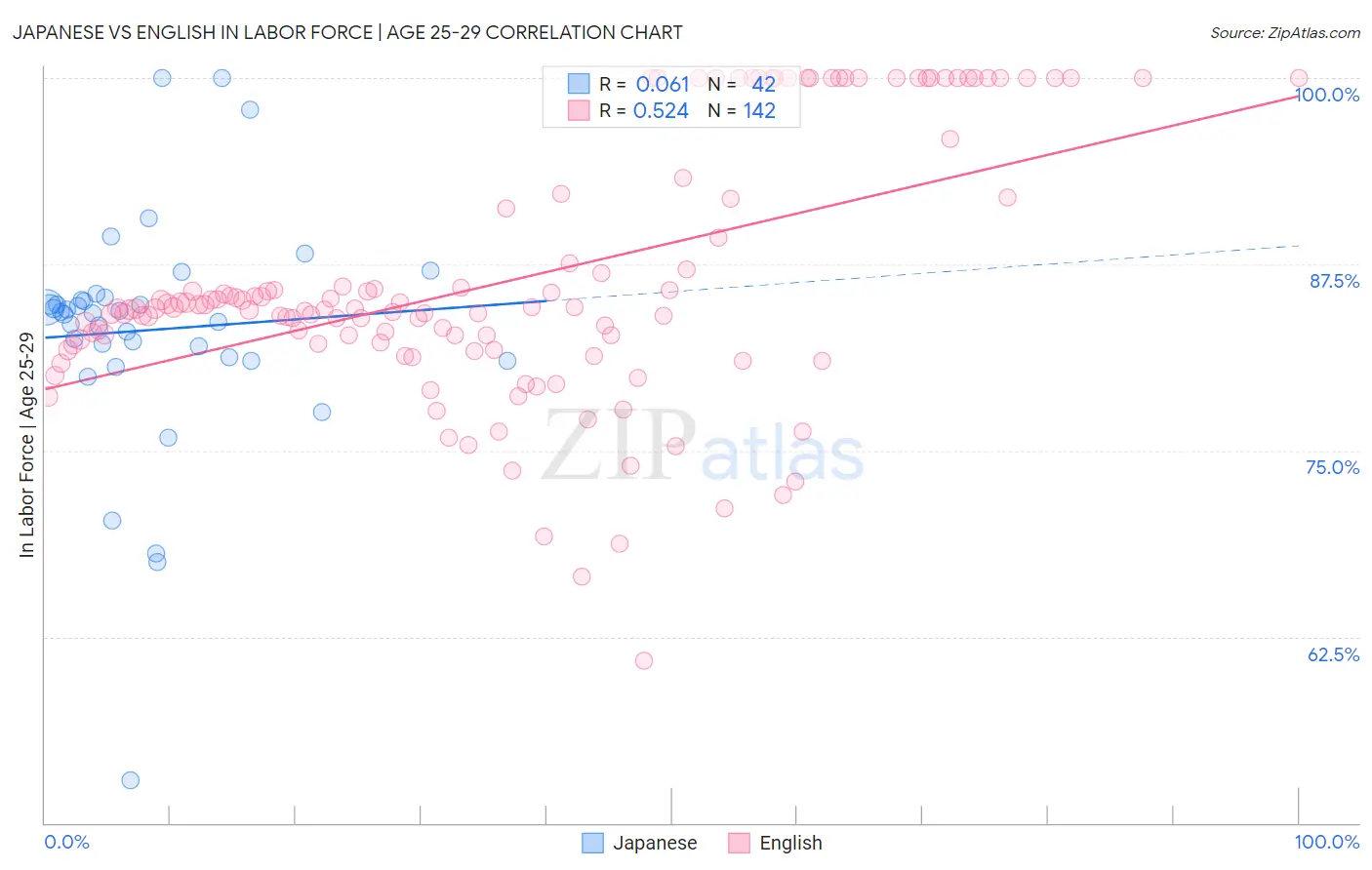Japanese vs English In Labor Force | Age 25-29
COMPARE
Japanese
English
In Labor Force | Age 25-29
In Labor Force | Age 25-29 Comparison
Japanese
English
84.3%
IN LABOR FORCE | AGE 25-29
11.4/ 100
METRIC RATING
213th/ 347
METRIC RANK
84.5%
IN LABOR FORCE | AGE 25-29
25.8/ 100
METRIC RATING
192nd/ 347
METRIC RANK
Japanese vs English In Labor Force | Age 25-29 Correlation Chart
The statistical analysis conducted on geographies consisting of 249,141,498 people shows a slight positive correlation between the proportion of Japanese and labor force participation rate among population between the ages 25 and 29 in the United States with a correlation coefficient (R) of 0.061 and weighted average of 84.3%. Similarly, the statistical analysis conducted on geographies consisting of 577,776,495 people shows a substantial positive correlation between the proportion of English and labor force participation rate among population between the ages 25 and 29 in the United States with a correlation coefficient (R) of 0.524 and weighted average of 84.5%, a difference of 0.18%.

In Labor Force | Age 25-29 Correlation Summary
| Measurement | Japanese | English |
| Minimum | 52.9% | 60.9% |
| Maximum | 100.0% | 100.0% |
| Range | 47.1% | 39.1% |
| Mean | 83.1% | 86.4% |
| Median | 84.3% | 84.5% |
| Interquartile 25% (IQ1) | 81.3% | 82.2% |
| Interquartile 75% (IQ3) | 85.1% | 91.9% |
| Interquartile Range (IQR) | 3.8% | 9.7% |
| Standard Deviation (Sample) | 8.0% | 8.6% |
| Standard Deviation (Population) | 7.9% | 8.6% |
Similar Demographics by In Labor Force | Age 25-29
Demographics Similar to Japanese by In Labor Force | Age 25-29
In terms of in labor force | age 25-29, the demographic groups most similar to Japanese are Subsaharan African (84.3%, a difference of 0.0%), Lebanese (84.3%, a difference of 0.010%), Immigrants from Syria (84.3%, a difference of 0.010%), Immigrants from Jordan (84.4%, a difference of 0.020%), and Chinese (84.3%, a difference of 0.020%).
| Demographics | Rating | Rank | In Labor Force | Age 25-29 |
| Immigrants | Cambodia | 14.3 /100 | #206 | Poor 84.4% |
| Immigrants | Armenia | 13.3 /100 | #207 | Poor 84.4% |
| Immigrants | Indonesia | 13.2 /100 | #208 | Poor 84.4% |
| Immigrants | Jordan | 12.8 /100 | #209 | Poor 84.4% |
| Chinese | 12.7 /100 | #210 | Poor 84.3% |
| Immigrants | Venezuela | 12.6 /100 | #211 | Poor 84.3% |
| Sub-Saharan Africans | 11.7 /100 | #212 | Poor 84.3% |
| Japanese | 11.4 /100 | #213 | Poor 84.3% |
| Lebanese | 11.1 /100 | #214 | Poor 84.3% |
| Immigrants | Syria | 10.7 /100 | #215 | Poor 84.3% |
| Israelis | 9.3 /100 | #216 | Tragic 84.3% |
| Immigrants | Ecuador | 9.3 /100 | #217 | Tragic 84.3% |
| Immigrants | Nigeria | 9.0 /100 | #218 | Tragic 84.3% |
| Immigrants | Saudi Arabia | 8.8 /100 | #219 | Tragic 84.3% |
| Nigerians | 7.2 /100 | #220 | Tragic 84.3% |
Demographics Similar to English by In Labor Force | Age 25-29
In terms of in labor force | age 25-29, the demographic groups most similar to English are South American Indian (84.5%, a difference of 0.010%), Zimbabwean (84.5%, a difference of 0.030%), Welsh (84.5%, a difference of 0.050%), Portuguese (84.4%, a difference of 0.050%), and Immigrants from Israel (84.4%, a difference of 0.050%).
| Demographics | Rating | Rank | In Labor Force | Age 25-29 |
| Immigrants | Denmark | 37.0 /100 | #185 | Fair 84.6% |
| Immigrants | Belgium | 35.0 /100 | #186 | Fair 84.6% |
| Immigrants | Portugal | 34.7 /100 | #187 | Fair 84.6% |
| Immigrants | Ukraine | 33.7 /100 | #188 | Fair 84.5% |
| Moroccans | 32.6 /100 | #189 | Fair 84.5% |
| Welsh | 31.1 /100 | #190 | Fair 84.5% |
| Zimbabweans | 28.7 /100 | #191 | Fair 84.5% |
| English | 25.8 /100 | #192 | Fair 84.5% |
| South American Indians | 25.0 /100 | #193 | Fair 84.5% |
| Portuguese | 21.2 /100 | #194 | Fair 84.4% |
| Immigrants | Israel | 20.8 /100 | #195 | Fair 84.4% |
| Immigrants | South Eastern Asia | 19.5 /100 | #196 | Poor 84.4% |
| Tlingit-Haida | 19.3 /100 | #197 | Poor 84.4% |
| Immigrants | Iraq | 19.0 /100 | #198 | Poor 84.4% |
| Immigrants | Germany | 18.3 /100 | #199 | Poor 84.4% |